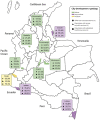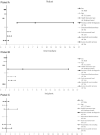Seroprevalence of SARS-CoV-2 Antibodies in Children and Adolescents: Results From a Population-Based Survey in 10 Colombian Cities
- PMID: 35342777
- PMCID: PMC8941708
- DOI: 10.1177/2333794X221085385
Seroprevalence of SARS-CoV-2 Antibodies in Children and Adolescents: Results From a Population-Based Survey in 10 Colombian Cities
Abstract
Background. Understanding COVID-19 dynamics in Colombia during the first pandemic year (2020) gives important insights surrounding population's exposure risk and specific susceptibilities. Seroprevalence studies can aid in having a broader understanding of the disease, offering a more inclusive view of the pandemic's impact across the population. Methods. A population-based cross-sectional study to assess antibodies against SARS-CoV-2 in 10 Colombian cities was developed between September and December 2020. Cities were grouped according development typology (Robust (RD), Intermediate (ID) and Incipient (InD)). Detection of total antibodies (IgM + IgG) against SARS-CoV-2 was employed. Univariate Odds Ratios (OR) were estimated for antibody results and selected variables. Results. About 3124 children aged between 5 and 17 years were included. Factors related to lower seropositive results were affiliation to the employer-based health insurance in RD and ID cities (OR: 0.579, 95% CI 0.477-0.703, OR: 0.648, 95%CI 0.480-0.874 respectively) and living in a household with adequate access to public services only for ID cities (OR: 0.679. 95% CI 0.491-0.939). Higher seropositivity rates in RD and ID cities were seen in children belonging to the low socioeconomic stratum (RD: OR: 1.758, 95% CI 1.427-2.165; ID: OR: 2.288, 95% CI 1.599-3.275) and living in an overcrowded household (RD: OR: 1.846, 95% CI 1.467-2.323; ID: OR: 2.379, 95% CI 1.769-3.199). Conclusions. Children and adolescents showed substantial impact from the COVID-19 pandemic. Disadvantageous living conditions were found to be significantly related to having a positive SARS-CoV-2 antibody test. These results highlight the need to prioritize vulnerable populations in the context of health emergencies.
Keywords: SARS-CoV-2; antibody; pediatric; seroepidemiology study; serology.
© The Author(s) 2022.
Conflict of interest statement
Declaration of Conflicting Interests: The author(s) declared no potential conflicts of interest with respect to the research, authorship, and/or publication of this article.
Figures


Similar articles
-
Seroprevalence of anti-SARS-CoV-2 antibodies in Colombia, 2020: A population-based study.Lancet Reg Health Am. 2022 May;9:100195. doi: 10.1016/j.lana.2022.100195. Epub 2022 Feb 5. Lancet Reg Health Am. 2022. PMID: 35156075 Free PMC article.
-
Nationwide seroprevalence of antibodies to SARS-CoV-2 in asymptomatic population in South Korea: a cross-sectional study.BMJ Open. 2021 Apr 24;11(4):e049837. doi: 10.1136/bmjopen-2021-049837. BMJ Open. 2021. PMID: 33895722 Free PMC article.
-
Assessment of initial SARS-CoV-2 seroprevalence in the most affected districts in the municipality of São Paulo, Brazil.Braz J Infect Dis. 2021 Jul-Aug;25(4):101604. doi: 10.1016/j.bjid.2021.101604. Epub 2021 Aug 10. Braz J Infect Dis. 2021. PMID: 34416142 Free PMC article.
-
Seroprevalence of anti-SARS-CoV-2 antibodies among staff at primary healthcare institutions in Prishtina.BMC Infect Dis. 2022 Jan 16;22(1):57. doi: 10.1186/s12879-022-07038-6. BMC Infect Dis. 2022. PMID: 35034617 Free PMC article.
-
High SARS-CoV-2 Seroprevalence in Rural Peru, 2021: a Cross-Sectional Population-Based Study.mSphere. 2021 Dec 22;6(6):e0068521. doi: 10.1128/mSphere.00685-21. Epub 2021 Nov 24. mSphere. 2021. PMID: 34817236 Free PMC article.
Cited by
-
SARS-CoV-2 Seroprevalence in a Berlin Kindergarten Environment: A Cross-Sectional Study, September 2021.Children (Basel). 2024 Mar 28;11(4):405. doi: 10.3390/children11040405. Children (Basel). 2024. PMID: 38671622 Free PMC article.
-
Psychosocial risk profiles to address future health emergencies: a country study during the COVID-19 lockdown period in Colombia.Front Public Health. 2024 Mar 22;12:1323490. doi: 10.3389/fpubh.2024.1323490. eCollection 2024. Front Public Health. 2024. PMID: 38605871 Free PMC article.
-
Serological surveillance reveals a high exposure to SARS-CoV-2 and altered immune response among COVID-19 unvaccinated Cameroonian individuals.PLOS Glob Public Health. 2024 Feb 12;4(2):e0002380. doi: 10.1371/journal.pgph.0002380. eCollection 2024. PLOS Glob Public Health. 2024. PMID: 38346064 Free PMC article.
-
SARS-CoV-2 infection in newborn infants: descriptive epidemiological analysis of cases reported to the Colombian national surveillance system during the first pandemic year, March 2020-February 2021.BMJ Paediatr Open. 2023 Mar;7(1):e001781. doi: 10.1136/bmjpo-2022-001781. BMJ Paediatr Open. 2023. PMID: 36863763 Free PMC article.
-
Seroprevalence of SARS-CoV-2 antibodies among children and adolescents recruited in a malariometric survey in north-eastern Tanzania July 2021.BMC Infect Dis. 2022 Nov 12;22(1):846. doi: 10.1186/s12879-022-07820-6. BMC Infect Dis. 2022. PMID: 36371172 Free PMC article.
References
-
- World health Organization. WHO Director-General’s opening remarks at the media briefing on COVID-19. WHO. April 2020:1-4. https://www.who.int/director-general/speeches/detail/who-director-genera.... Accesed July 2021.
LinkOut - more resources
Full Text Sources
Miscellaneous

